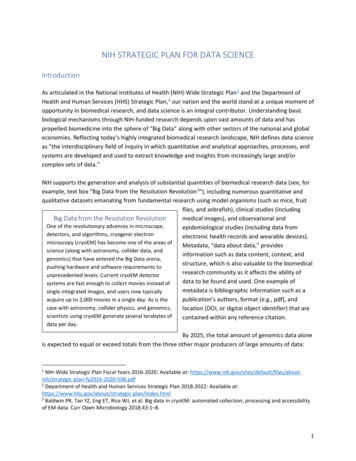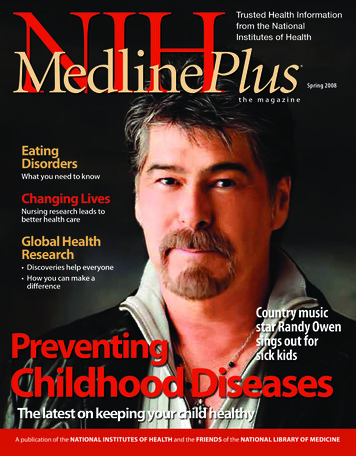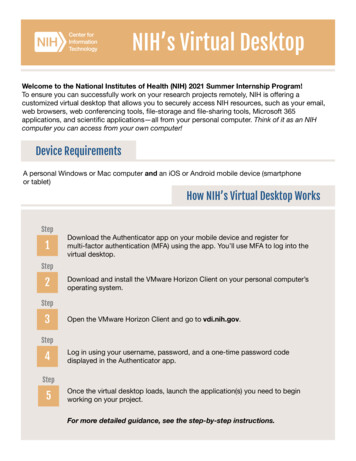
Transcription
FORMS VERSION F SERIESReleased: October 16, 2020RESEARCH INSTRUCTIONS FOR NIHAND OTHER PHS AGENCIESSF424 (R&R) APPLICATION PACKAGESGuidance developed and maintained by NIH for preparing andsubmitting applications via Grants.gov to NIH and other PHSagencies using the SF424 (R&R)
Research Instructions for NIH and Other PHS Agencies - Forms Version F SeriesTABLE OF CONTENTSTABLE OF CONTENTS2R.100 - How to Use the Application Instructions3R.110 - Application Process6R.120 - Significant Changes10R.130 - Program Overview16R.200 - SF 424 (R&R) Form18R.210 - PHS 398 Cover Page Supplement Form32R.220 - R&R Other Project Information Form37R.230 - Project/Performance Site Location(s) Form46R.240 - R&R Senior/Key Person Profile (Expanded) Form50R.300 - R&R Budget Form61R.310 - R&R Subaward Budget Attachment(s) Form75R.320 - PHS 398 Modular Budget Form78R.400 - PHS 398 Research Plan Form84R.500 - PHS Human Subjects and Clinical Trials Information97R.600 - PHS Assignment Request Form134Form ScreenshotsTABLE OF CONTENTSiR-2
Research Instructions for NIH and Other PHS Agencies - Forms Version F SeriesR.100 - How to Use the ApplicationInstructionsUse these application instructions to fill out the forms that are posted in your fundingopportunity announcement.View the How to Apply Video Tutorials.Quick LinksStep 1. Become familiar with the application processStep 2. Use these instructions, together with the forms and information in the funding opportunityannouncement, to complete your applicationStep 3. Choose an application instruction formatStep 4. Complete the appropriate formsStep 5. Stay informed of policy changes and updatesStep 6. Understand what data NIH makes publicHelpful LinksThe information on the following pages may be useful in the application processlOER GlossarylGrants Policy StatementlGuide to Grants and ContractslFrequently Asked QuestionsStep 1. Become familiar with the application process.Understanding the application process is critical to successfully submitting your application.Use the R.110 - Application Process section of these instructions to learn the importance ofcompleting required registrations before submission, how to submit and track your application,where to find page limits and formatting requirements, and more information about theapplication process.R.100 - How to Use the Application InstructionsR-3
Research Instructions for NIH and Other PHS Agencies - Forms Version F SeriesStep 2. Use these instructions, together with the forms and informationfound in the funding opportunity announcement, to complete yourapplication.The funding opportunity announcement (FOA) will include specific instructions and the formsneeded for your application submission.Remember that the FOA instructions always supersede these application instructions.Step 3. Choose an application instruction format.Do you know your activity code, but don’t know which application instructions to use? Refer toNIH’s table on Selecting the Correct Application Instructions to determine which set ofapplication instructions applies to your grant program.Comprehensive InstructionsProgram-Specific InstructionsUse the General (G) instructions, available in Take advantage of the filtered PDFs to viewboth HTML and PDF format, to completespecific application instructions for:the application forms for any type of grantlResearch (R)program.lCareer Development (K)lTraining (T)lFellowship (F)lMulti-project (M)lSBIR/STTR (B)Step 4. Complete the appropriate forms.Unless otherwise specified in the FOA, follow the standard instruction, as well as any additionalprogram-specific instructions for each form in your application.Program-specific instructions are presented in gray call-out boxes that are color codedthroughout the application instructions. Consult the R.130 - Program Overview section forcontext for program specific instructions.Step 5. Stay informed of policy changes and updates.llRefer to the R.120 - Significant Changes section for the most recent changes to theseapplication instructions.Review Notices of NIH Policy Changes since the posting of the Application Guide.R.100 - How to Use the Application InstructionsR-4
Research Instructions for NIH and Other PHS Agencies - Forms Version F SeriesStep 6. Understand what data NIH makes public.Information submitted as part of the application will be used by reviewers to evaluate thescientific merit of the application and by NIH staff to make the grant award and monitor thegrant after award. The exception to this is the R.600 - PHS Assignment Request Form, which isonly seen by staff in the Division of Receipt and Referral (DRR), Center for Scientific Review (CSR).If the application is funded, the following fields will be made available to the public through theNIH Research Portfolio Online Reporting Tool (RePORTER) and will become public information:lName of Project Director/Principal Investigator (PD/PI), to also include Project Leaders on subprojects to multi-project projectslPD/PI titlelPD/PI email addresslOrganizational namelInstitutional addresslProject summary/abstractlPublic health relevance statementIn addition, key elements related to ongoing funded projects will be made available to the public,including those listed in the data dictionary at ExPORTER. Additional elements may be madeavailable after announcements through the NIH Guide for Grants and Contracts, a weeklyelectronic publication that is available on NIH’s Funding page, or additions to the NIH GrantsPolicy Statement, as needed.R.100 - How to Use the Application InstructionsR-5
Research Instructions for NIH and Other PHS Agencies - Forms Version F SeriesR.110 - Application ProcessUnderstanding the application process is critical to successfully submitting your application.Use this section of this guide to learn the importance of completing required registrationsbefore submission; how to submit and track your application; where to find informationabout page limits, formatting requirements, due dates, and submission policies; and moreinformation about the application process. This application process information is alsoavailable on our How to Apply – Application Guide page.Quick LinksPrepare to Apply and RegisterWrite ApplicationSubmitRelated ResourcesPrepare to Apply and RegisterSystems and RolesLearn about the main systems involved in application submission and the role you and yourcolleagues play in the submission process. The main systems are Grants.gov, eRA Commons, andASSIST.RegisterDetermine your registration status. Organizations, organizational representatives, investigators,and others need to register in multiple federal systems in order to for you to submit a grantapplication. Registration can take six weeks or more to complete. Start today! See NIH’sRegistration website.Understand Funding OpportunitiesIdentify the right funding opportunity announcement (FOA) for your research and learn aboutkey information you will find in the FOA.Types of ApplicationsAre you submitting a new, renewal, revision, or resubmission application? Learn about thedifferent types of applications and special submission requirements.Submission OptionsDetermine which system is most convenient for your application submission: NIH’s ASSIST webbased application submission system, Grants.gov Workspace, or, if applicable, yourorganization’s own submission system.R.110 - Application ProcessR-6
Research Instructions for NIH and Other PHS Agencies - Forms Version F SeriesObtain SoftwareApplicants must have the free Adobe Reader software, a PDF generator, and a web browser tosubmit an application. Learn which versions are compatible with our systems.Write ApplicationWrite Your ApplicationRead tips for developing a strong application that helps reviewers evaluate its science and merit.Develop Your BudgetLearn about the kinds of costs you may include in your budget submission, the differencebetween modular and detailed budgets, and more about how to develop your budget.Format AttachmentsFollow these requirements for preparing the documents you attach to your application.Requirements include criteria for the PDF files, fonts, margins, headers and footers, paper size,citations, formatting pages, etc.Rules for Text FieldsLearn the rules for form text fields – allowable characters, cutting and pasting, character limits,and formatting.Page LimitsFollow the page limits specified in this table for your specific grant program, unless otherwisespecified in the FOA.Data TablesFind instructions, blank data tables, and samples to use with institutional research trainingapplications.Reference LettersSome types of programs, such as fellowships and some career development awards, require thesubmission of reference letters by the referee. Learn about selecting a referee and findinstructions for submission.BiosketchesBiosketches are required in both competing applications and progress reports. Find instructions,blank format pages, and sample biosketches.SubmitSubmit, Track and ViewLearn how to submit your application, and about your responsibility for tracking your applicationand viewing the application image in the eRA Commons before the application deadline. If youcan’t view your application in eRA Commons, we can’t review it.R.110 - Application ProcessR-7
Research Instructions for NIH and Other PHS Agencies - Forms Version F SeriesHow We Check for CompletenessYour application will be checked at Grants.gov, by eRA systems, and by federal staff before it isreferred for review.Changed/Corrected ApplicationsYou will need to submit a changed/corrected application to correct issues that either you or oursystems find with your application. Learn how and when you may submit a changed/correctedapplication.Related ResourcesDue Dates and PoliciesDue DatesView standard due dates for competing applications. The FOA will identify whether to followstandard due dates or whether to follow an alternative due date.Submission PoliciesLearn the nuances of application submission policies, including when late applications might beallowed, what to do if due dates fall on a weekend or holiday, whether we allow post-submissionmaterials, how to document system issues, the rules around resubmission applications, etc.Dealing with System IssuesAre you experiencing system issues with ASSIST, Grants.gov, System for Award Management(SAM), or the eRA Commons that you believe threaten your ability to submit on time? NIH will notpenalize applicants who experience confirmed issues with federal systems that are beyond theircontrol. You must report the problem before the submission deadline.After SubmissionReceipt and ReferralUnderstand how and when applications are given an application identification number andassigned to a review group and an NIH Institute or Center (IC) for possible funding.Peer ReviewLearn about our two phase peer review process, including initial peer review, Council review,review criteria, scoring, and summary statements.Pre-award ProcessLearn what happens between peer review and award for applications that have been deemedhighly meritorious in the scientific peer review process. Be ready: if you received a great score inpeer review, you’ll have to submit Just-in-Time information.Post award Monitoring and ReportingIf you receive a grant from the NIH, you will need a lot of information to be a successful stewardof federal funds. This page provides a brief overview of grantee monitoring and reportingrequirements.R.110 - Application ProcessR-8
Research Instructions for NIH and Other PHS Agencies - Forms Version F SeriesResourcesNews - Items of InterestThe NIH eSubmission Items of Interest page provides comprehensive information, in an informalformat, on the changes impacting application development and submission.Annotated Form SetsThese handy documents are a great visual resource for understanding many of the validationchecks we will run against your submitted application.Contacting NIH StaffNIH staff is here to help. We strongly encourage NIH applicants and grantees to communicatewith us throughout the grant life cycle. Understanding the roles of NIH staff can help you contactthe right person at each phase of the application and award process.Contacting Staff at Other PHS AgenciesApplicants are strongly encouraged to communicate with agency staff throughout the entireapplication review and awards process.SystemsASSISTeRA CommonsGrants.govInformation CollectionAuthorizationThe PHS Act establishes the authority with which NIH and other PHS agencies award grants andcollect information related to grant awards.Paperwork BurdenThe paperwork burden provides the estimated time for completing a grant application.Collection of Personal Demographic DataNIH collects personal data through the eRA Commons Personal Profile. The data is confidentialand is maintained under the Privacy Act record system.R.110 - Application ProcessR-9
Research Instructions for NIH and Other PHS Agencies - Forms Version F SeriesR.120 - Significant ChangesThe Application Instructions are updated and released 2-3 times per year as needed.Additionally, minor revisions may be made outside of these releases.This section details all significant changes and revisions made to the instructions since thelast major release.Within the instructions, new instructions will be marked with this symbol.In the web version, use your mouse to hover over the icon to read an explanation of thechange.In a PDF version, this symbol will be visible but will not display hover text. For moreinformation, see the explanation in the Significant Changes section below.Revision Notes - October 16, 2020PHS 398 Career Development Award Supplemental FormlUnder "12. Description of Candidate's Contribution to Program Goals", added hyperlink to Noticeof NIH's Interest in Diversity (NOT-OD-20-031).PHS 398 Research Training Program Plan FormlUnder section “C. Recruitment Plan to Enhance Diversity” of the “Program Plan”, added hyperlinksto the Notice of NIH’s Interest in Diversity (NOT-OD-20-031).PHS Human Subjects and Clinical Trials InformationllRemoved language that indicated to skip the rest of the form if you answered “No” to the “Doesthe proposed research involve human specimens and/or data?” question.Modified text in instruction to “4.1.d. Study Phase” to match form option “N/A”.Form ScreenshotslUpdated form screenshotsR.120 - Significant ChangesR - 10
Research Instructions for NIH and Other PHS Agencies - Forms Version F SeriesRelease Notes - February 25, 2020SF 424 Research and Related (R&R) Form ChangesFORMS-F application packages incorporate the latest versions of the federal-wide formsmanaged by Grants.gov (OMB Number: 4040-0001, Expiration Date: 12/31/2022).SF 424 (R&R) FormllClarified instructions regarding Agency Routing Identifier.Added instructions for applications proposing the use of human fetal tissue obtained from electiveabortions (HFT):lllAdded language under section "21. Cover Letter Attachment," sub-section content (Item9).Updated general and SBIR/STTR instructions for the Type of Applicant question, as “WomenOwned” and “Socially and Economically Disadvantaged” information is now collected though SAM.Clarified instruction regarding the content of the "Cover Letter Attachment" to indicate that itmust not be used to communicate application assignment preferences.R&R Senior/Key Person Profile (Expanded) FormllAdded instructions for Career Development and Fellowship applications for the “Credential, e.g.,agency login” field under the PD/PI Credential Field of the "Profile- Project Director/PrincipalInvestigator" section.Made minor text edits.R&R Budget and associated R&R Subaward Budget Attachment(s) FormlllWithin section F. Other Direct Costs: “8-10: Other”- removed instruction to list inpatient andoutpatient care costs specifically on lines 8 and 9.Within section F. Other Direct Costs: “8-10: Other”- removed note regarding requesting anexception to the single IRB (sIRB) policy.Added instructions for applications proposing the use of human fetal tissue obtained from electiveabortions (HFT):oAdded special instruction for proposed human fetal tissue research under “Who should usethe R&R Budget Form?”llllAdded special instructions under “Additional Instructions for Multi-project”.Added special instruction for proposed human fetal tissue research under section “F.8-10.Other.”Added special instruction for proposed human fetal tissue research under section “L. BudgetJustification.”Added special instruction for proposed human fetal tissue research under section “F.1. Materialsand Supplies.”R.120 - Significant ChangesR - 11
Research Instructions for NIH and Other PHS Agencies - Forms Version F SerieslMade minor text edits.Forms-F ChangesPHS 398 Cover Page Supplement FormlUpdated OMB Expiration Date to 2/28/2023lAdded new "Human Fetal Tissue" Section.llAdded instructions for applications proposing the use of human fetal tissue obtained fromelective abortions (HFT).Added new "Does the proposed project involve human fetal tissue obtained from electiveabortions?" field.lAdded new instructions and attachment for "HFT Compliance Assurance."lAdded new instructions and attachment for "HFT Sample IRB Consent Form."lRenumbered form fields.PHS 398 Modular Budget FormllUpdated OMB Expiration Date to 2/28/2023.Added instructions for applications proposing the use of human fetal tissue obtained fromelective abortions (HFT):llAdded special instruction for proposed human fetal tissue research under "Whoshould use the PHS 398 Modular Budget Form?"Made minor text edits.PHS 398 Training Budget FormlUpdated OMB Expiration Date to 2/28/2023PHS 398 Training Subaward Budget Attachment(s) FormlUpdated OMB Expiration Date to 2/28/2023PHS Additional Indirect Costs FormlUpdated OMB Expiration date to 2/28/2023PHS 398 Research Plan FormUpdated OMB Expiration Date to 2/28/2023Clarified instructions on the content of the "Letters of Support" attachment in the "OtherResearch Plan Section."llRemoved previous instructions for applications submitted for due dates on or before January24, 2019 within section 3, "Research Strategy."Added instructions for applications proposing the use of human fetal tissue obtained fromelective abortions (HFT):R.120 - Significant ChangesR - 12
Research Instructions for NIH and Other PHS Agencies - Forms Version F SeriesoUnder the introductory part of section 3, "Research Strategy": Added new section titledNote for Applications Proposing the Use of Human Fetal Tissue.nlWithin section 3 "Research Strategy", subsection 3 "Approach" - added a newbullet point for this information titled 'Special Instructions for Proposed HumanFetal Tissue Research."Made minor text edits.PHS 398 Career Development Award Supplemental FormllUpdated OMB Expiration Date to 2/28/2023Added instructions about rigor, experimental design, and quantitative approaches to the“Candidate Information and Goals for Career Development” section.lAdded new “Description of Candidate’s Contribution to Program Goals” attachment.lRenumbered form fields.lloRemoved previous instructions for applications submitted for due dates on or before January24, 2019 within section 4 "Research Strategy."Added instructions for applications proposing the use of human fetal tissue obtained fromelective abortions (HFT):Under the introductory part of Section 4 "Research Strategy:: Added a new section titled Notefor Applications Proposing the Use of Human Fetal Tissue.nlWithin Section 4 "Research Strategy" - subsection 3 "Approach" - added a new bulletpoint for this information titled Special Instructions for Proposed Human Fetal TissueResearch.Made minor text edits.PHS 398 Research Training Program Plan FormllllUpdated OMB Expiration Date to 2/28/2023Removed previous instructions for applications submitted for due dates on or before January24, 2019 within Section 8 "Letters of Support."Added instructions to the “Proposed Training” section of the “Program Plan” about rigor,experimental design, and quantitative approaches.Added instructions for the “Plan for Instruction in Methods for Enhancing Reproducibility”attachment.lUpdated instructions for the “Progress Report (for Renewal applications)” attachment.lMade minor text edits.PHS Fellowship Supplemental FormlllUpdated OMB Expiration Date to 2/28/2023Added instructions about rigor, experimental design, and quantitative approaches to the“Training Goals and Objectives” section of the “Applicant’s Background and Goals forFellowship Training” attachment.Added instructions for the “Authentication of Key Biological and/or Chemical Resources” field.R.120 - Significant ChangesR - 13
Research Instructions for NIH and Other PHS Agencies - Forms Version F SerieslAdded new “Description of Candidate’s Contribution to Program Goals” attachment.lRenumbered form fields.lMade minor text edits.PHS Human Subjects and Clinical Trials InformationllUpdated OMB Expiration date to 2/28/2023.oChanges were made to the form’s organization in the following sections:oWho should use the PHS Human Subjects and Clinical Trials Information formoUsing the PHS Human Subjects and Clinical Trials Information formoUse of Human Specimens and/or DataClarified and updated instructions throughout. Significant changes were made for thefollowing fields:o“Provide the ClinicalTrials.gov Identifier”o“Section 2 – Study Population Characteristics” instructions now reflect updatedexceptions for required questions.oStudy TimelineoSection 3.2: "Is this a multi-site study that will use the same protocol to conduct nonexempt human subjects research at more than one domestic site?" - reflect updatedinstructions.o“Data and Safety Monitoring Plan” attachmentlUpdated instructions for delayed onset studies regarding use of single IRB.lAdded new “Inclusion of Individuals Across the Lifespan” attachment.lUpdated instructions for the “Inclusion of Women and Minorities” attachment to reflectseparate “Inclusion of Individuals Across the Lifespan” attachment.lAdded new “Inclusion Enrollment Report Title” field.lRemoved the “Brief Summary” field.Changed the “Narrative Study” field to “Detailed Description.”lUpdated instructions to Section 3.2 "Is this a multi-site study that will use the same protocolto conduct non-exempt human subjects research at more than one domestic site?" and thesingle IRB plan attachment.olIncluded instructions specific for AHRQ applicants.Included instructions specific for AHRQ applicants to Section 3.3 "Data and Safety MonitoringPlan."lAdded new "Is this an applicable clinical trial under FDAAA?" field.lRenumbered form fields.R.120 - Significant ChangesR - 14
Research Instructions for NIH and Other PHS Agencies - Forms Version F SeriesPHS Assignment Request FormlUpdated OMB Expiration Date to 2/28/2023.lUpdated language in the form to clarify that this form is for suggestions.llRemoved the “Do Not Assign to Awarding Component” and “Do Not Assign to Study Section”fields and instructions.Added new “Rationale for assignment suggestions” field.R.120 - Significant ChangesR - 15
Research Instructions for NIH and Other PHS Agencies - Forms Version F SeriesR.130 - Program OverviewQuick LinksResearch and Other ("R" Series).Research and Other ("R" Series)The purpose of research and other awards is to provide support for health-related research anddevelopment based on the mission of the NIH. Some examples of support include pilot studies;conferences and scientific meetings; small research projects; institutional training and directorprogram projects; resource programs; and new, exploratory, and developmental researchprojects. Awards may be in the form of grants or cooperative agreements.Additional Instructions for Research:Additional research instructions will be denoted by a gray call-out box with yellowcolor coding and with the heading “Additional Instructions for Research”throughout these application instructions.Before Applying:1. Become familiar with Activity Code: Applicants should become familiar with theactivity code for which support is being requested. These include many “R” activity codes,as well as some “DP,” “G," “S,” and “U” activity codes. A comprehensive list of all activitycodes, with their descriptions, is available on NIH’s Activity Codes Search Results website.2. Refer to your specific FOA: Refer to your FOA for specific information associated withthe award mechanism, including the eligibility requirements, review criteria, awardprovisions, any special application instructions, and names of individuals who may becontacted for additional or clarifying information prior to application submission.3. Contact Awarding Component: Applicants are encouraged to consult with the NIHScientific/Research contact of the appropriate awarding component prior to submittingan application, as eligibility criteria, support levels, and availability of awards may varyamong NIH Institutes or Centers and other PHS agencies.The following chart provides a summary of the existing research programs; however, the chart isnot a comprehensive list of activity codes. Since this information is subject to change, prospectiveapplicants are encouraged to review NIH’s Types of Grant Programs for the most currentprogram information.R.130 - Program OverviewR - 16
Research Instructions for NIH and Other PHS Agencies - Forms Version F SeriesSummary of Research Award Programs*ActivityCodeProgram DescriptionR01Research ProjectR03NIH Small Grant ProgramR13ConferenceR15NIH Academic Research Enhancement Award (AREA)R21NIH Exploratory/Developmental Research Grant AwardR25Education ProjectsU01Research Project – Cooperative AgreementsU13Conference - Cooperative AgreementsG07Resources Improvement GrantS10Biomedical Research Support Shared Instrumentation GrantsDP1NIH Director's Pioneer Award (NDPA)*This is not a comprehensive list of activity codes.R.130 - Program OverviewR - 17
Research Instructions for NIH and Other PHS Agencies - Forms Version F SeriesR.200 - SF 424 (R&R) FormThe SF 424 (R&R) Form is used in all grant applications.This form collects information including type ofsubmission, applicant information, type of applicant,and proposed project dates.View larger imageQuick Links1. Type of Submission2. Date Submitted and Applicant Identifier3. Date Received by State and State Application Identifier4a. Federal Identifier4b. Agency Routing Identifier4c. Previous Grants.gov Tracking ID5. Applicant Information6. Employer Identification7. Type of Applicant8. Type of Application9. Name of Federal Agency10. Catalog of Federal Domestic Assistance Number and Title11. Descriptive Title of Applicant's Project12. Proposed Project13. Congressional District of Applicant14. Project Director/Principal Investigator Contact Information15. Estimated Project Funding16. Is Application Subject to Review by State Executive Order 12372 Process?17. Certification18. SFLLL (Disclosure of Lobbying Activities) or Other Explanatory Documentation19. Authorized Representative20. Pre-application21. Cover Letter AttachmentR.200 - SF 424 (R&R) FormR - 18
Research Instructions for NIH and Other PHS Agencies - Forms Version F Series1. Type of SubmissionThis field is required. Check one of the "Type of Submission" boxes:Pre-application:The pre-application option is not used by NIH or other PHS agencies unless specifically noted in afunding opportunity announcement (FOA).Application:An "Application" is a request for financial support of a project or activity submitted on specifiedforms and in accordance with NIH instructions. (See NIH Types of Applications for an explanationof the types of applications).Changed/Corrected Application:Check this box if you are correcting either system validation errors or application assemblyproblems that occurred during the submission process. Changed/corrected applications must besubmitted before the application due date.When you submit a changed/corrected application, follow these guidelines:lllAfter submission of an application, there is a two-day application viewing window. Prior to thedue date, you may submit a changed/corrected application. Submitting a changed/correctedapplication will replace the previous submission and remove the previous submission fromconsideration.If you check the “Changed/Corrected Application” box, then "Field 4.c Previous Grants.govTracking ID” is required.Do not use the “Changed/Corrected Application” box to denote a resubmission application.Resubmission applications will be indicated in “Field 8. Type of Application.” See NIH Glossaryfor the definition of Resubmission.2. Date Submitted and Applicant IdentifierThe “Date Submitted” field will auto-populate upon application submission.Fill in the “Applicant Identifier” field, if applicable. The Applicant Identifier is reserved for applicantuse, not the federal agency to which the application is being submitted.3. Date Received by State and State Application IdentifierSkip the “Date Received by State” and “State Application Identifier” fields.4.a. Federal IdentifierNew Applications without Pre-application: Leave this field blank.New Applications following Pre-application: Enter the agency-assigned pre-applicationnumber.R.200 - SF 424 (R&R) FormR - 19
Research Instructions for NIH and Other PHS Agencies - Forms Version F SeriesResubmission, Renewal, and Revision Applications: The Federal Identifier is required. Includeonly the IC and serial number of the previously assigned application/award number (e.g., useCA987654 from 1R01CA987654-01A1).4.b. Agency Routing IdentifierSkip the “Agency Routing Identifier” field unless otherwise specified in the FOA or notice in theNIH Guide for Grants & Contracts.Applications in response to a NIH Notice of Special Interest require the notice number (e.g., NOTIC-FY-XXX) to be entered into this field in order to assign and track applications and awards forthe described initiative.4.c. Previous Grants.gov Tracking IDThe “Previous Grants.gov Tracking ID” fiel
R.220 - R&R Other Project Information Form 37 R.230 - Project/Performance Site Location(s) Form 46 R.240 - R&R Senior/Key Person Profile (Expanded) Form 50 R.300 - R&R Budget Form 61 R.310 - R&R Subaward Budget Attachment(s) Form 75 R.320 - PHS 398 Modular Budget Form 78 R.400 - PHS 398 Research Plan Form 84











